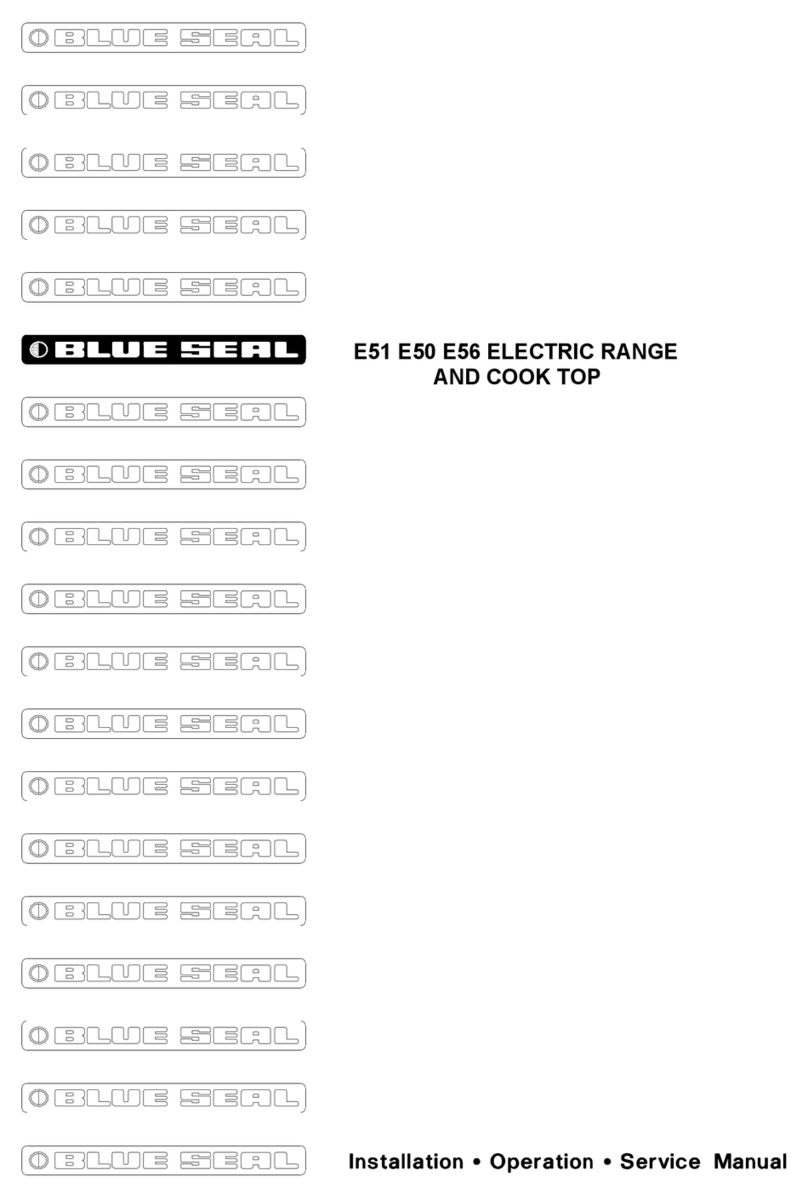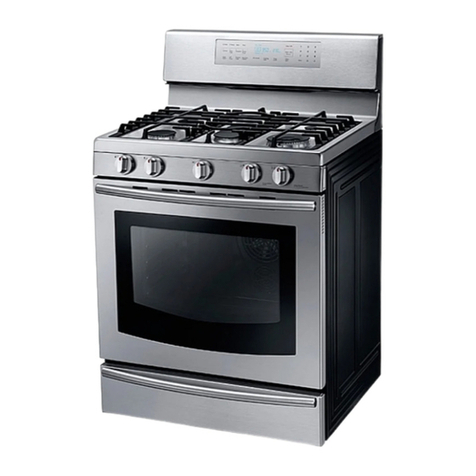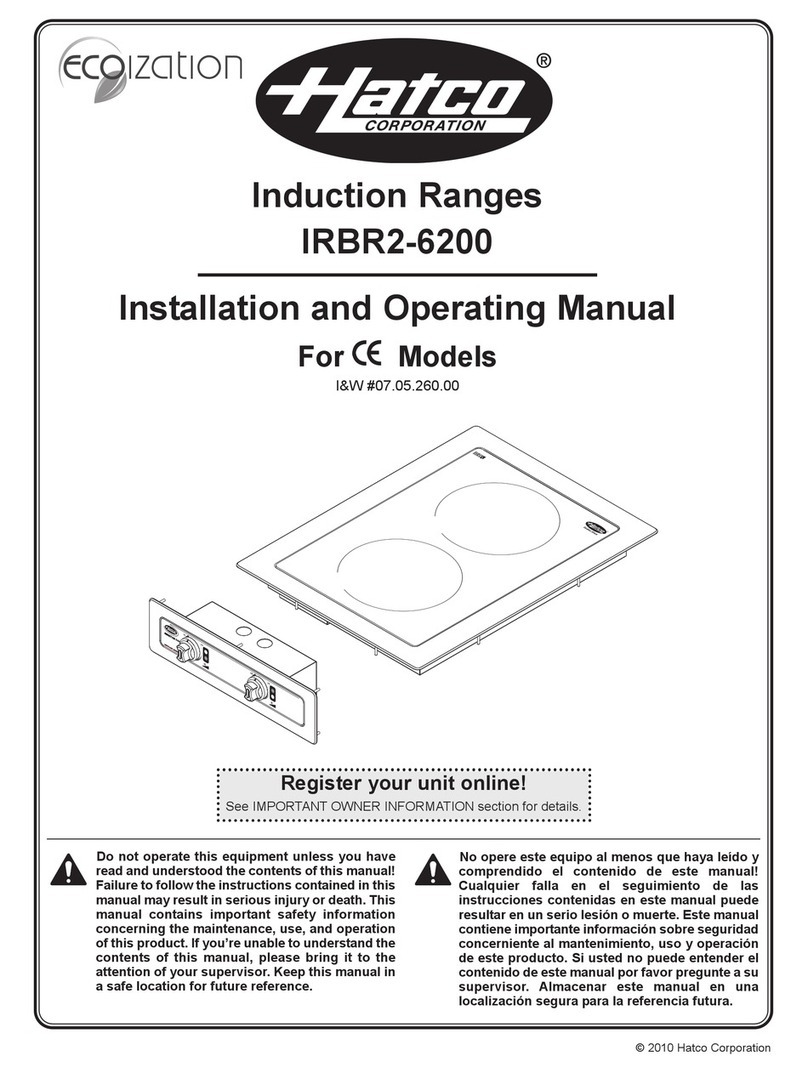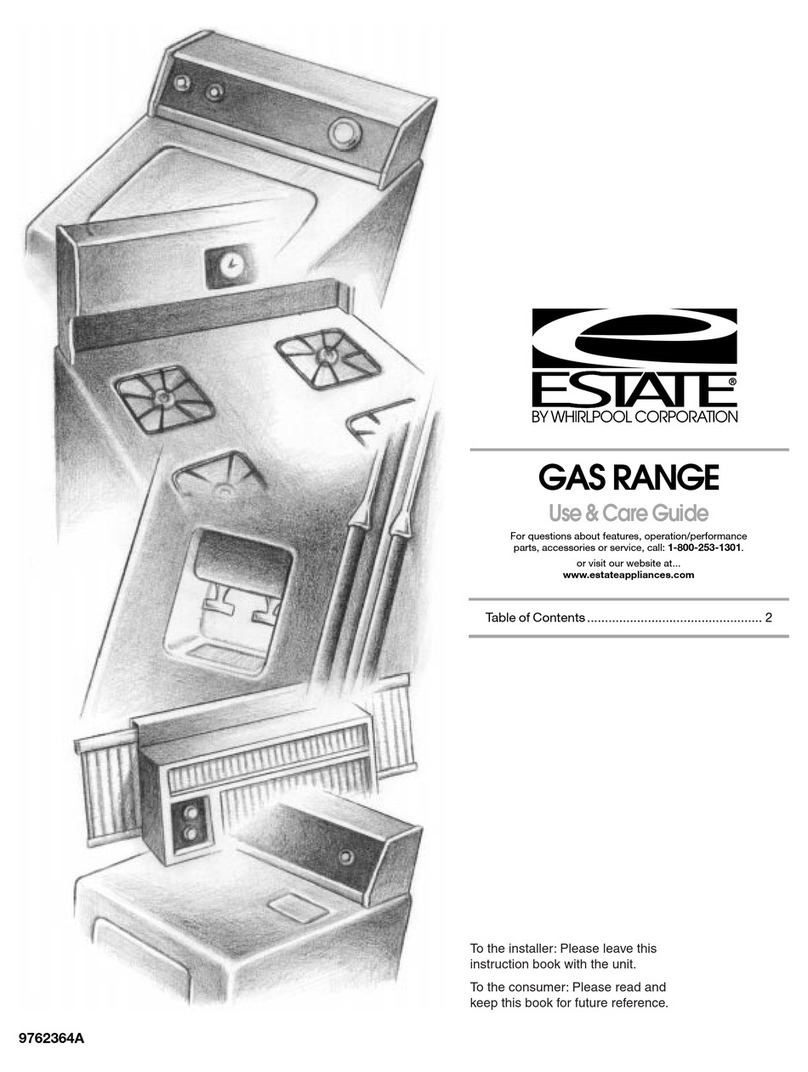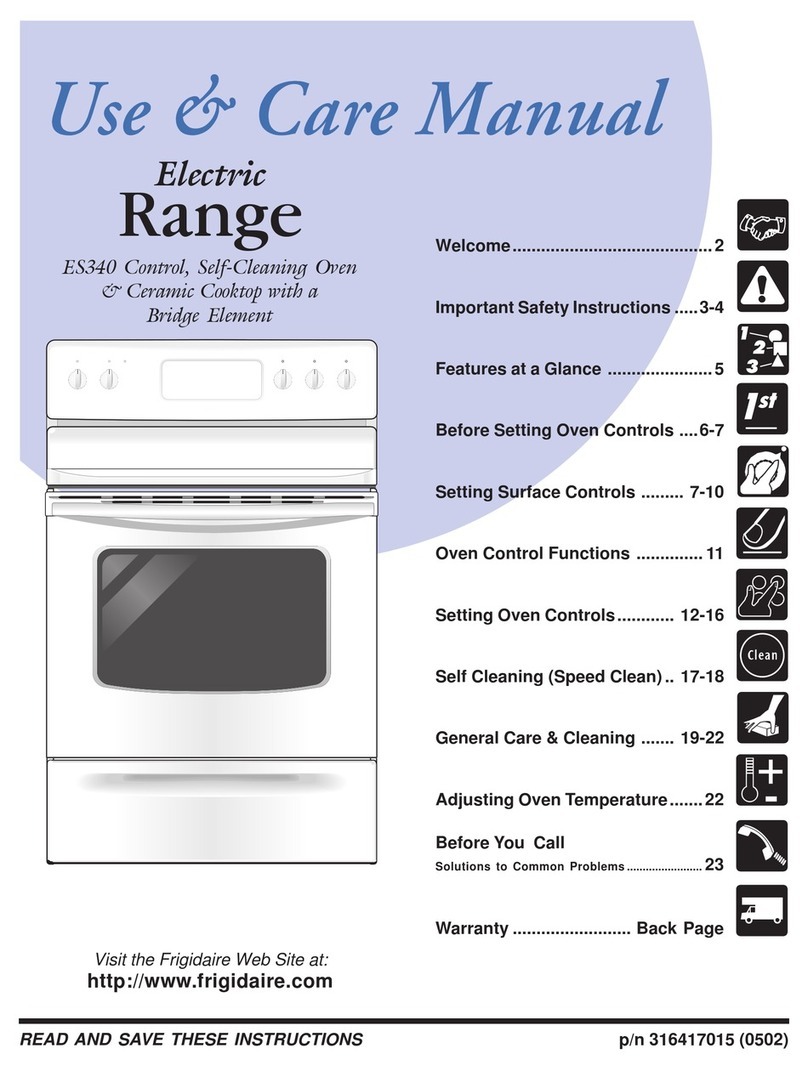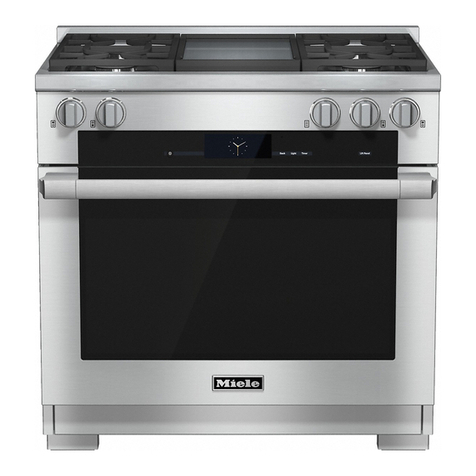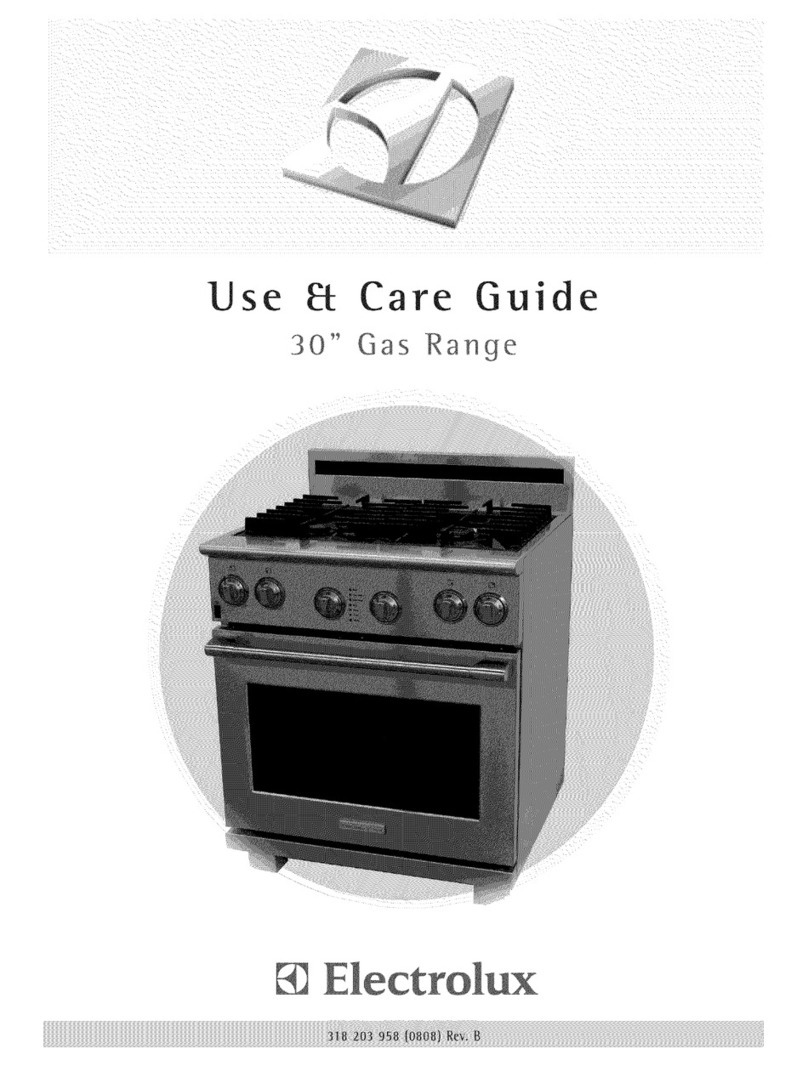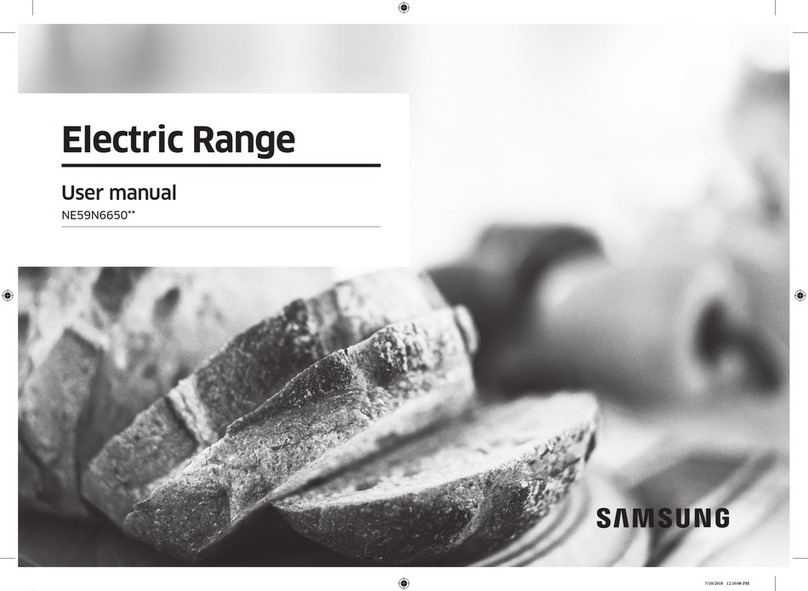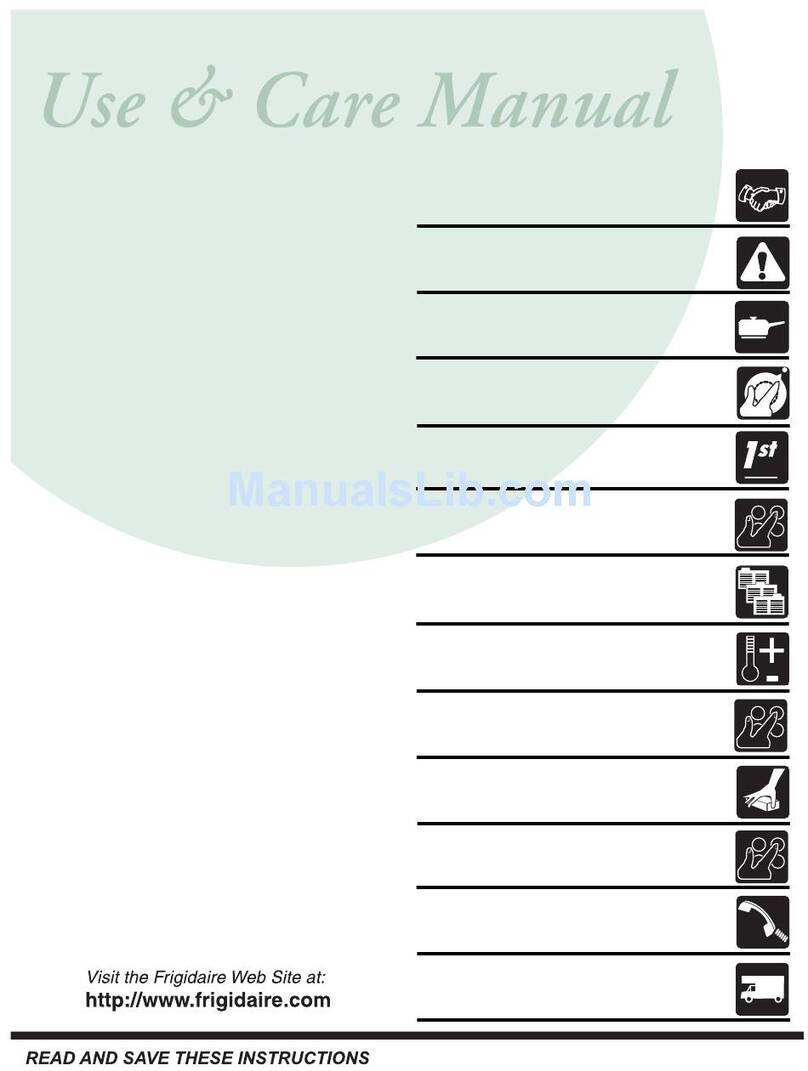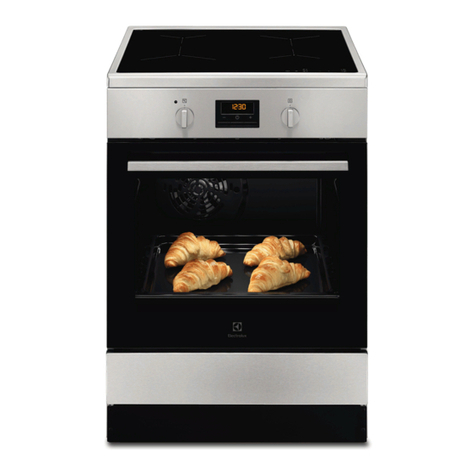Sub-Zero Wolf ICBDF364G User manual

Page 2
1-5 #814889- Revision A- July, 2010
General Information
International Dual Fuel (ICBDF) Series
International Dual Fuel (ICBDF) Series
WARRANTY INFORMATION
This page contains a summary of the 2 & 5 Year Warranty that is supplied with every Wolf product, followed by
details and notes about the warranties.
TWO & FIVE YEAR Warranty Summary
• Two year TOTAL PRODUCT warranty, parts and labor.
• Limited Parts Only Warranty for the 3rd through 5th year on the following parts only:
- Electric Heating Elements
- Electronic Control Boards
Warranty Details:
The warranty applies only to products installed for normal residential use. The warranty applies only to product
installed in the United States or Canada.
Warranty Notes:
• All warranties begin at the time of the unit’s initial installation.
• All Warranty and Service information collected by Wolf Appliance, Inc. is arranged and stored under the unit seri-
al number and/or the customer’s name. Please note that Wolf Appliance, Inc. requests that you have the model
serial number available whenever contacting the factory or parts distributor.
(See Figure 1-1 for Serial Tag Layout, and Figure 1-2 for Serial Tag Location)
Wolf Appliance Company, LLC
Fitchburg, WI
Gas INPUT RATING EACH BURNER - BTU/HR
Man. Press. Left Rear Burner – Other Top Burners -
Griddle – Charbroiler – French Top –
ELECTRICAL RATING: Volts – Amps – Hertz -
Model # - Serial # -
BD
MINIMUM HORIZONTAL CLEARANCE FROM SIDES AND BACK OF APPLIANCE TO ADJACENT COMBUST-
IBLE CONSTRUCTION EXTENDING 18” ABOVE THE COOKING SURFACE 12” FROM SIDE WALLS 0” FROM
REAR WALL MINIMUM CLEARANCE BETWEEN ADJACENT COMBUSTIBLE MATERIALS BELOW THE
COOKING SURACE AND THE BACK AND SIDE OF THE APPLIANCE: 0”. MAXIMUM DEPTH FOR OVERHEAD
CABINETS IS 13” MINIMUMBERTICAL DISTANCE BETWEEN THE COOKING SURFACE AND THE BACK AND
SIDE OF THE APPLIANCE: 30”, MINIMUM VERTICAL DISTANCE BETWEEN THE TOP BROILER GRID TO
UNPROTECTED OVERHEAD COMBUSTIBLE SURFACES 36”, MINIMUM HORIZONTAL DISTANCE BETWEEN
OVERHEAD CABINETS INSTALLED TO EITHER SIDE OF THE APPLIANCE SHALL NOT BE LESS THAN THE
NOMINAL WIDTH OF APPLIANCE TO BE USED IN CONJUNCTION WITH A SUITABLE VENT HOOD ONLY.
COOKING UTENSILS SHALL NOT BE USED ON AN OPEN TOP BROILER SECTION, MINIMUM HORIZONTAL
CLEARANCE FROM ISLAND INSTALLTION COOKTOP TO COMBUSTIBLE SIDE AND BACK WALL IS 12”
“ANSI Z21.1 “HOUSEHOLD GAS COOKING APPLIANCES”
“CSA IR 58, 1995”
Figure 1-1. Typical Serial Tag Layout
Figure 1-2. Serial Tag Located Under Control Panel
Serial Tag Located
Underneath Bottom
of Control Panel

Page 3
1-2
#814889 - Revision A - July, 2010
General Information International Dual Fuel (ICBDF) Series
International Dual Fuel (ICBDF) Series
INTRODUCTION
This Technical Service Manual has been compiled to provide the most recent technical service information about this
series. This information will enable the service technician to troubleshoot and diagnose malfunctions, perform nec-
essary repairs, and return the appliance to proper operational condition.
The service technician should read the complete instructions contained in this Technical Service Manual before initi-
ating any repairs on a Wolf Appliance.
* Some information in Section 3 (Operation Information) has been provided by the American Gas Association and
reprinted with AGA’s approval.
IMPORTANT SAFETY INFORMATION
Below are Product Safety Labels used in this manual.
The "Signal Words" used are WARNING or CAUTION.
When reviewing this manual, please note these differ-
ent Product Safety Labels placed at the beginning of
certain sections of this manual. You must follow the
instructions given in the boxes of the Product Safety
Labels in order to avoid personal injury and/or product
damage.
The sample Product Safety Labels below illustrate the
precautions that should be taken when the signal word
is observed.
INDICATES THAT HAZARDOUS OR UNSAFE
PRACTICES COULD RESULT IN SEVERE PERSON-
AL INJURY OR DEATH!
Indicates that hazardous or unsafe practices could
result in minor personal injury, and/or product
damage, and/or property damage!
In addition, please pay attention to the signal word
“NOTE”, which highlights information that is especially
important for the topic being covered.
TECHNICAL ASSISTANCE
If you should have any questions regarding a Wolf appli-
ance and/or this manual, please contact:
Wolf Appliance, Inc.
ATTN: Service Department
P.O. Box 44988
Madison, Wisconsin, USA, 53744-4988
Customer Service & Parts / Warranty Claims
Domestic Toll Free Phone #: (800) 332 - 9513
International Toll Charge Phone #: (608) 271 - 2233
Technical Assistance
Domestic Toll Free Phone #: (800) 919 - 8324
International Toll Charge Phone #: (608) 271 - 2233
Customer Service & Technical Assistance
International Toll Charge Facsimile #: (608) 441 - 5887
Parts / Warranty Claims
International Toll Charge Facsimile #: (608) 441 - 5886
Service Department e-mail Address
Office Hours:
7:00 AM to 6:00 PM Central Time
Monday through Friday
This manual is designed to be used by Authorized Service Personnel only. Wolf Appliance, Inc. assumes
no responsibility for any repairs made on Wolf appliance units by anyone other than Authorized Service
Technicians.
The information and images contained in this manual are the copyright property of Wolf appliance, Inc. Neither this
manual nor any information or images contained herein may be copied or used in whole or in part without the
express written consent of Wolf Appliance, Inc.©, all rights reserved.

Page 4
1-6
#814889 - Revision A - July, 2010
General Information International Dual Fuel (ICBDF) Series
International Dual Fuel (ICBDF) Series
FEATURES, MODES AND SPECIAL COMPONENTS
• Natural or LP gas rangetop with electric convection oven(s)
• Blue porcelain oven interior
• Stainless steel exterior finish
• Platinum bezel surrounds all control knobs
• Option of Red or Black control knobs
• Coaxial temperature displaying oven knob
• Pivoting touch control panel for oven(s)
• Continuous cast iron porcelain top grates
• Oven door windows and dual halogen lighting
• Spring / damper door system
• All burners except one on rangetop are dual stacked sealed 15,000 BTU burners
• Melt feature on the one dual stacked sealed 9,200 BTU burner
• All dual stacked burners have simmer capabilities
• All dual stacked burners have automatic re-ignition
• 11” or 22” 15,000 BTU (13,000 BTU - LP) Griddle with Infrared burner(s) and safety shut off system
• 11” or 22” 16,000 BTU Charbroiler with Infrared burner(s)
• 22” 15,000 BTU French Top burner with safety shutoff system
• Multiple oven cooking modes
1. Bake Mode
2. Broil Mode
3. Roast Mode
4. (Bake) Stone Mode - (Not available with 18” oven cavity)
5. Proof Mode (18” oven cavity only - This differs from the Proof “Feature” of the 30” and 36” cavities)
6. Convection Bake Mode
7. Convection Broil Mode
8. Convection Roast Mode
9. Convection Mode
• Self-cleaning Mode with all ovens
• Dehydration Feature
• Proof Feature (30” and 36” cavities only - This differs from the Proof “Mode” of the 18” oven cavity)
• Delayed Start Feature
• Temperature Probe Feature
• Sabbath Feature
• 30” and 36” oven cavities are dual convection; 18” oven cavity is single convection
• Full extension bottom rack
• Hidden bake element
• Adjustable stainless steel legs in front and adjustable rear casters
• Optional Bake Stone

Page 5
1-7 #814889- Revision A- July, 2010
General Information
International Dual Fuel (ICBDF) Series
International Dual Fuel (ICBDF) Series
MODEL NUMBER KEY
Refer to this key for an example of the model numbers.
Model: ICBDF 36 4C - LP
Product Type
ICBDF = International Dual Fuel
Size
36 = 36 inch wide unit
48 = 48 inch wide unit
60 = 60 inch wide unit
Surface Burners
2 = Two sealed burners
4 = Four sealed burners
6 = Six sealed burners
Model Features
C = Charbroiler (11'')
G = Griddle (11'')
F = French Top (22'')
DG = Dual Griddle (22'')
DC = Dual Charbroiler (22'')
Fuel
LP = Liquid Propane Gas
NOTE:If “LP” is not indicated at the end of model, as shown in the above example, then the unit is Natural Gas.

Page 6
1-8
#814889 - Revision A - July, 2010
General Information International Dual Fuel (ICBDF) Series
International Dual Fuel (ICBDF) Series
TOP CONFIGURATIONS OF ICB DUAL FUEL RANGES
ICBDF486C 48” Dual Fuel Range with Six Burners and 11” Charbroiler
ICBDF486G 48” Dual Fuel Range with Six Burners and 11” Griddle
ICBDF484CG 48” Dual Fuel Range with Four Burners and 11” Charbroiler and
11” Griddle
ICBDF484DC 48” Dual Fuel Range with Four Burners and 22” Double Charbroiler
ICBDF366 36” Dual Fuel Range with Six Burners
ICBDF364C 36” Dual Fuel Range with Four Burners and 11” Charbroiler
ICBDF364G 36” Dual Fuel Range with Four Burners and 11” Griddle
ICBDF606CG 60” Dual Fuel Range with Six Burners and 11” Charbroiler and
11” Griddle
ICBDF604CF 60” Dual Fuel Range with Four Burners and 11” Charbroiler and
22” French Top
NOTE:LP units will be designated with a “-LP” at the end of the model number. Natural gas units will have no des-
ignation at the end of the model number.

Page 7
International Dual Fuel (ICBDF) Series
International Dual Fuel (ICBDF) Series
Installation Information
2-2
#814889 - Revision A- July, 2010
INSTALLATION INFORMATION
This section of the manual covers some of the installation issues that a service technician may need to know when
servicing a Wolf ICB Dual Fuel Range. If additional installation information is needed after reviewing this section of
the manual, please refer to the Installation Guide or contact the Wolf Appliance Customer Service Department.
Electrical Requirements
Required Electrical Supply:
•230 volts AC, 50/ Hertz, 15 ampere fused electrical supply for 36” units.
•230 volts AC, 50/60 Hertz, 28 ampere fused electrical supply for 48” and 60” units.
•Separate circuit serving only this appliance.
•Installation site must be equipped with a properly grounded receptacle.
Minimum Electrical Wire Size:
30” and 36”
•L1 - 0.82mm2(18 AWG)
•Neutral - 0.82mm2(18 AWG)
•Ground - 0.82mm2(18 AWG)
48” and 60”
•1 and L2 - 2.08mm2(14 AWG)
•Neutral - 2.08mm2(14 AWG)
•Ground - 2.08mm2(14 AWG)
The unit is designed with a terminal block on the rear of the range. The terminal block allows for 3-wire or 4-wire
installation. For a 4-wire installation, the ground strap from the unit to the terminal block must be cut. Two concen-
tric knockouts (on the terminal block), are provided to allow a certified electrical contractor to wire the range directly
to a junction box.
The terminal block will also accept an appliance power cord. The power cord must be sized correctly for the units
voltage and amperage.
Please refer to state, municipal and local codes for the best means to connect the appliance to the electrical
power supply.
A SHOCK HAZARD COULD EXIST IF THE ELECTRIC RECEPTACLE OR THE POWER CORD ARE NOT PROP-
ERLY GROUNDED AND POLARIZED.
The appliance may experience ignition problems if not properly grounded and polarized.

Page 8
Installation Information
International Dual Fuel (ICBDF) Series
International Dual Fuel (ICBDF) Series
2-3 #814889 - Revision A- July, 2010
Gas Requirements
Wolf ICB Dual Fuel Ranges are manufactured to work with natural gas or LP gas (Liquid Propane gas). The model /
serial rating plate, located on the bottom of the control panel assembly just above the oven door on the far right, has
information on the type of gas that should be used. If this information does not agree with the type of gas available,
check with the local gas supplier.
Natural Gas Manifold Pressure:
Standard natural gas orifices on the appliance are set for 20 m bar (8” WC - Water Column Pressure).
Liquid Propane Manifold Pressure:
The standard propane gas orifices on the appliance are set for 37 m bar (14.1” WC - Water Column Pressure).
Gas Supply Line Size:
• 3/4 inch rigid pipe to the range location
• For LP gas, piping or tubing size can be 13mm (1/2") minimum.
NOTE:A smaller size pipe on long runs may result in insufficient gas supply.
A CSA design-certified, 914 mm long, 123mm (1/2") or 19 mm (3/4") ID, flexible metal appliance connector is recom-
mended for connecting this range to the gas supply line.
Do not kink or damage the connector when moving the range.
Gas Supply Pressure:
•Maximum line pressure for natural = 25 m bar (10” WC) gas and LP = 45 m bar (18” WC); 3.5 kPa (1/2 psi).
•Minimum line pressure for natural gas is 17 m bar (7 WC).
•Minimum line pressure for LP gas is 25 m bar (10” WC).

Page 9
International Dual Fuel (ICBDF) Series
International Dual Fuel (ICBDF) Series
Installation Information
2-4
#814889 - Revision A- July, 2010
Leak Testing
Use a brush and liquid detergent to test all gas connections for leaks. Bubbles around connections will indicate a
leak. If a leak appears, shut off gas valve controls and adjust connections. Then check connections again. Clean all
the detergent solution from the range.
An electronic leak detector can also be utilized to test for leaks.
NEVER USE OPEN FLAMES TO CHECK FOR GAS LEAKS. DO NOT USE LIQUID NEAR VALVE STEMS.
Shut-off Valve
(open position)
To Cooktop
Gas Supply Line
Figure. 2-1. Shut-off Valve
Manual
Shut-off Valve
1/2" Adapter 1/2" Adapter
Pressure
Regulator
1/2" Nipple
(use pipe-joint compound) 1/2" Nipple
(use pipe-joint compound)
Flexible Metal Connector
Figure. 2-2. Gas Connection
Supply Line Connection
All connections must be wrench-tightened. Do not make connections to gas piping too tight. Making the connection
too tight may crack regulator and cause a gas leak. Do not allow pipes to turn when tightening fittings, tubing in the
burner box may also bend and begin to leak.
Assemble flexible metal connector from gas supply pipe to pressure regulator. Determine fittings required, depend-
ing on size of gas supply line, flexible metal connector and shut-off valve (See Figure 3-2).
Use a pipe-joint compound made for use with natural and LP gas. If flexible metal connector is used, be
sure tubing is not kinked.
Gas Shut-off Valve
The supply line must be equipped with an approved shut-off valve. This valve should be located in accordance to all
national, local codes and ordinances (See Figure 3-1).

Page 10
Figure 2-3. Dimension Chart
Installation Information
International Dual Fuel (ICBDF) Series
International Dual Fuel (ICBDF) Series
2-5 #814889 - Revision A- July, 2010
E
LOCATION OF
ELECTRICAL
36"
(91.4)
36 7/8"
(93.7) TO
COOKING
SURFACE
30" min (76.2)
COOKING SURFACE
TO COMBUSTIBLE
CONSTRUCTION
44" min (91.4)
TO CHARBROILER
30" min (76.2)
TO BOTTOM OF
VENTILA
TION HOOD
VENTILATION HOOD
COMBUSTIBLE CONSTRUCTION
18" min (45.7)
TO COOKING
SURFACE
13" max
(33.0)
LOCATION OF GAS AND
ELECTRICAL EXTENDS 3"
ON FLOOR FROM BACK WALL
ISLAND INSTALLATIONS: 12" MINIMUM
CLEARANCE FROM BACK OF RANGE
TO COMBUSTIBLE CONSTRUCTION
B
FINISHED ROUGH OPENING WIDTH
COOKING SURFACE
C
31/4"
(8.3)
D
LOCATION
OF GAS
SUPPL
Y
6" min
(15.2)
TO WALL
35 7/8"
(91.1)
36 7/8" (93.7)
TO COOKING
SURFACE
36 7/8"
(93.7)
OVERALL
HEIGHT
A
OVERALL WIDTH
25" (63.5)
24 1/4"
(61.6)
27 1/2"
(69.9)
29 1/2" (74.9)
OVERALL DEPTH
LEGS AND CASTERS ALLOW
21/8" HEIGHT ADJUSTMENT
INSTALLATION DIMENSIONS
Installation Dimensions 30" Range 36" Range 48" Range 60" Range
A*Overall width of range 759 mm 911 mm 1216 mm 1527 mm
BFinished rough opening width 762 mm 914 mm 1219 mm 1530 mm
CDimension from edge of rough opening 216 mm 216 mm 610 mm 787 mm
DLocation of gas supply 254 mm 381 mm 254 mm 254 mm
ELocation of electrical 330 mm 457 mm 330 mm 330 mm
*width may vary to +3 mm

Page 11
International Dual Fuel (ICBDF) Series
International Dual Fuel (ICBDF) Series
Installation Information
2-6
#814889 - Revision A- July, 2010
Anti-Tip Bracket Installation
Raise the unit to desired height using the rear leveling
casters and adjusting the front adjustable legs.
Try fitting the unit in place to verify the correct height.
Measure from the floor to the top of the range base
flange on the back of the unit. Add 1/8"(3.175mm) to
this dimension, mark this height on the wall behind the
unit. This will be the location of the bottom edge of the
anti-tip bracket. Try to center the mark between the
cabinets.
For 48-inch and 60-inch ranges, care must be taken to
verify that the anti-tip bracket does not interfere with the
inner cavity supports. Locate a stud or other solid
mounting source, install the anti-tip bracket at the same
level as this line. Push the unit back, ensure the rear
base flange fits under the anti-tip bracket (See Figure 2-
3).
ANTI-TIP BRACKET MUST BE ANCHORED TO
WALL BEHIND UNIT SO IT IS DIRECTLY ABOVE
THE BASE FLANGE OR APPLIANCE MAY TIP FOR-
WARD.
SIDE PANEL
ANTI-TIP
BRACKET
BASE FLANGE
WALL
FLOOR
TO FLOOR
5 3/4" min.
Figure 2-4. Anti-Tip Installation
CASTERS ALLOW
2 1/8" HEIGHT ADJUSTMENT
FLOOR
Figure 2-5. Caster Height
Figure 2-6. Caster and Leveling Leg Adjustment
UNIT LEVELING
Rear Caster Adjustment
The ICB Dual Fuel range has rolling casters, which
allows easy movement of the range by picking up the
front of the unit. The range comes from the factory at
an overall height of 35-7/8"(911.225mm) (from floor to
top of the bullnose) before any height adjustment. The
casters allow for 2-1/8"(53.975mm) height adjustment.
NOTE:Do not lift by oven door(s) handle.
To raise or lower rear caster, reach directly underneath
unit to rear caster and attach a 3/4” socket with an long
extension onto the adjusting bolt located on front of
caster assembly. Now, attach a drill or socket wrench
to extension and turn bolt left or right to raise or lower
(See Figure 2-6).
Front Leveling Leg Adjustment
Dual Fuel ranges can be leveled at the front by turning
the front leveling legs as indicated in figure 3-6 The
legs allow for 2-1/8" height adjustment.
To raise or lower front leveling legs, use an adjustable
wrench to turn the leveling leg nut to the left or right to
raise or lower (See Figure 2-6).
The stainless steel cover over the leveling leg floats up
or down to conceal the leveling leg from view. If level-
ing leg is still visible and the stainless steel cover is all
the way down, replace the stainless steel cover with a
longer version, available as a sales accessory.

Page 12
International Dual Fuel (ICBDF) Series
International Dual Fuel (ICBDF) Series
Operation & Electronic Control
3-2
#814889 - Revision A- July, 2010
THEORY OF OPERATION
A service technician should understand how a gas appliance operates before attempting to service the appliance.
This section provides descriptions of the different types of fuel gases and explains gas heating values. A definition
of specific gravity of gas is given along with its characteristics and effects. Gas combustion principals are explained
and gas burner components are described and illustrated. The end of this section contains illustrations which
demonstrate basic cooking appliance theory of operation.
Types of Fuel Gas:
Gases used to supply heat energy are called fuel gases. Common fuel gases are not simply one kind of hydrocar-
bon, they are mixtures of hydrocarbon gases. They contain other gases as well, such as free hydrogen, carbon
dioxide and nitrogen. As an example natural gas might contain 85% methane, 12% ethane and 3% of other gases.
The presence of each of these gases in the fuel gas has some effect on the nature of the gas.
Some common fuel gasses are methane [CH4], ethane [C2H6], Propane [C3H8] and butane [C4H10]. Propane and
butane are nearly odorless. Natural gas that is processed to remove condensable and moisture, has little or no odor
and no color. Odorants are added to natural gas before distribution to aid in leak detection. A common odorant
used is a colorless liquid containing sulfur compounds.
Heating Value of Gas:
Heat energy produced when burning a fuel gas is commonly expressed in British Thermal Units (BTU). One BTU of
heat will raise the temperature of one pound of water one degree Fahrenheit.
The more carbon and hydrogen atoms in each molecule of a fuel gas, the higher its heating value. Natural gas
which is high in methane has a heating value of about 950 to 1150 BTU per cubic foot. The variance is due to the
various other substances found in natural gases. The more ethane, propane or butane in the gas raises the heating
value. Propane, or LP gas, has a heating value of about 2500 BTU per cubic foot, and butane about 3200 BTU per
cubic foot.
Specific Gravity of Gas:
The specific gravity of a gas is the weight of one cubic foot, or the gas compared to one cubic foot of dry air. When
stating the specific gravity of a gas, a pressure and temperature must be clearly stated. In the gas industry, the
standard conditions of pressure and temperature are 30.0 inches of mercury and 60° F. A pressure of 30.0 inches of
mercury will sustain a column of mercury 30 inches high in a tube with a vacuum on top of the column. Since air is
used as the reference, its specific gravity is always 1.0. This value of 1.0 has no direct physical meaning with
regard to air, such as its density. It is only a relative number or ratio used to express specific gravity of other gases.
The specific gravity of a gas will determine if the gas will rise or fall when released into the air. Natural gas will rise
since its specific gravity is less than 1.0 at 0.4 to 0.8. Propane has a specific gravity of 1.5 and butane 2.0. These
gases will fall when released into the air. They sometimes collect in low spots into pools which become a hazard if
open flames are present.
In addition, specific gravity has two other characteristics. It has an important effect on the flow of gases through ori-
fices, and hence the rating of the burners. Gas flow through an orifice is dependent upon the orifice size and the
gas pressure upstream of the orifice. More of a lighter gas will flow through a given orifice size than a heavier gas
at the same gas pressure. This effect is taken into account in tables and calculators used to select orifice sizes for
burners.
The gas flow in pipes is also affected by specific gravity. At a given pressure at a pipe inlet, more lighter gas will
flow through a pipe than a heavier gas.

Page 13
Operation & Electronic Control
International Dual Fuel (ICBDF) Series
International Dual Fuel (ICBDF) Series
3-3 #814889 - Revision A - July, 2010
Principals of Gas Combustion:
Combustion
When oxygen acts with a substance to produce large amounts of heat rapidly.
Requirements for Combustion
There are three required elements for combustion to occur; Fuel (Gas), Oxygen (Air) and Heat (Ignition
Temperature, which for gas is between 1100°F/593°C and 1200°F/649°C). All must be present. Removing any one
of the three and combustion will cease.
Chemistry of Combustion
Combustion of gas is a chemical reaction between fuel gas and oxygen. The basic elements of common fuel
gasses are hydrogen [H] and carbon [C]. When hydrogen burns, water vapor [H2O] is produced. Complete burning
of carbon in fuel gases form carbon dioxide [CO2] and water vapor [H2O].
Controlled Combustion
Controlled combustion takes place when gas and air are supplied at proper rates to assure complete combustion of
the gas in a steady flame. When a gas appliance is operating properly, burning starts at the burner ports. Gas flow
is controlled by gas orifice size and gas pressure upstream of the orifice. Air is mixed with the gas before it passes
through the burner ports. This added air is called “Primary Air”. The remaining air required for complete combustion
is supplied to the burner at the point of combustion and is called “Secondary air”.
Adjustments of the gas-to-air ratio and the secondary air supply is the key to obtaining stable blue flames at a burn-
er. Proper amounts of primary and secondary air are required for quiet and efficient burner operation and for com-
plete combustion of the gas. Air Shutters or other devices provide control of primary air. Inlet opening and flue out-
lets control Secondary Air flow.
Total air
In an ideal situation, primary and secondary air is all that is needed (for the oxygen required) to burn the gas, but
some additional air is required to assure complete burning of the gas. The total air, “primary”, “secondary” and
“excess” are expressed as percentages of the amount needed. About ten cubic feet of air is required to completely
burn one cubic foot of gas. For this reason an appliance should not be operated in an air tight home.
Limits of Flammability
Not all air-to-gas mixtures will burn. Mixtures with 0% - 4% natural gas in air are too lean to burn. Mixtures of 4% -
14% natural gas in air can burn with a controlled flame. Flammability limits come into play when primary air adjust-
ments are made on burners. If too much primary air is used, the mixture may become too lean and fall below flam-
mability limits, thus preventing combustion.
Incomplete Combustion (Causes and Effects)
To obtain complete combustion, sufficient amounts of air must be supplied to the process. This air must have a rea-
sonably normal oxygen content. Complete burning of gas produces harmless carbon dioxide gas and water vapor.
If the air supply is insufficient, incomplete combustion occurs resulting in the formation of toxic by-products, such as
carbon monoxide [CO] or aldehydes.
Carbon monoxide is colorless and odorless. Inhaling carbon monoxide in sufficient quantities could cause death by
reducing oxygen levels in the blood.
Aldehydes, which are equally dangerous, have a sharp and penetrating odor which is easily detected by smell at
very low concentrations. The odor caused by aldehydes should not be confused with odorants added to natural gas.
The absence of aldehydes does not assure that carbon monoxide is not present. However, if the odor of aldehydes
is present, then carbon monoxide is virtually always present.
Gas Burner Operation
A gas burner is a device to burn gas under control in order to produce useful heat. Primary air is brought into the
burner from outside of the appliance at atmospheric pressure. The gas jet streaming from the orifice draws primary
air with it into the burner.
The gas/air mixture, combined with a spark at the burner port(s) and the secondary air creates a controlled burn.

Page 14
International Dual Fuel (ICBDF) Series
International Dual Fuel (ICBDF) Series
Operation & Electronic Control
3-4
#814889 - Revision A- July, 2010
Figure 3-1. Burner Components
Electrode
Burner
Burner Cap
Orifice Holder
Simmer Orifice
Main Orifice
Venturi
Burner Components (Refer to Figure 3-1):
Burner Cap - Provides the upper portion of the ports required to create a combustible mix and proper flame quality
of the burner and the decorative top for the burner with a black porcelain coating.
Burner - Contains the burner ports where the gas/air mixture ignites. The burner ports are distributed in a useful
pattern to optimize heat transfer. The flames should be spread so they can be easily reached by secondary air and
provide a stable blue flame. The burner also incorporates the Inner Distribution Ring, which Routes the gas from the
simmer orifice to the simmer port holes, and the Outer Distribution Ring, which routes the gas from the main burner
orifice to the main burner port holes.
Venturi - Helps maintain proper and constant primary air injection.
Electrode - The Electrode supplies the spark to ignite the burner. The electrode senses the flame, once the burner
is ignited and will stop sparking. If no flame is sensed, and the valve is opened, the electrode will start sparking to
re-ignite the flame. This is part of the auto-reignition system.
Orifice Holder - This component is mounted to the burner mounting bracket and to the burner box. The Simmer
and Main orifice is threaded into the orifice holder and routes the gas to the appropriate ports of the burner. It is the
main support for the burner components.
Simmer Orifice and Main Orifice - An opening or hole which regulates or limits the amount of gas flowing to a
burner. Gas flow rate (volume) depends on the size of the orifice (hole) and the gas pressure at the inlet of the ori-
fice.

Page 15
Operation & Electronic Control
International Dual Fuel (ICBDF) Series
International Dual Fuel (ICBDF) Series
3-5 #814889 - Revision A - July, 2010
Types of Burners:
Blue Flame Burners
All Wolf open surface burners, including the French Top burners are blue flame burners. With this type of burner,
primary air is mixed with the fuel gas before the gas reaches the burner ports. An orifice is used to regulate gas
flow to the burner and is sized to draw exact amount of air into the burner body. Air, which is mixed with the gas
inside the burner body then exits the burner ports located in the burner head, where it is ignited. Secondary air is air
from around the flames. The flame produced has several zones, each represents a stage in burning of the gas.
The burner tip has a thin dark blue cone called the inner or primary cone. A lighter cone called the outer cone, sur-
rounds the inner cone. Air around the flame diffuses into the flame to burn at the outer cone. If conditions are per-
fect, products from the inner cone burn here. The final products of burning are carbon dioxide and water vapor. An
outer mantle surrounds the outer cone where burning is usually completed. It is nearly invisible and glows only
because of the high temperature of the final combustion.
Infrared Burners
Wolf dual fuel ranges also use infrared burners. The under-fired application for the charbroiler and the griddle uses
a porous refractory ceramic tile burner (See Figure 3-2). With this type of burner, a substantial amount of energy
output is in the form of infrared radiant energy. With infrared heat, thermal energy is transmitted through space with-
out heating the medium through which it travels. Infrared energy is usually not affected by air flowing between the
burners and heated surfaces because of the burner’s numerous and tiny flames. This type of heat is very efficient
and compact. The under-fired refractory infrared burner requires 100 percent primary air and is designed to have a
hot glowing burner surface. The flame burns close to the burner surface at a high temperature.
NOTE: There is no shutter on infrared burners for adjusting the primary air and there is no change in orifice size for
different altitude.
Figure 3-2. Infrared Burner
Charbroiler and Griddle Orifice
Gas Orifice
Elbow

Page 16
International Dual Fuel (ICBDF) Series
International Dual Fuel (ICBDF) Series
Operation & Electronic Control
3-6
#814889 - Revision A- July, 2010
Burner Cap
Igniter
Sealed Burner
Alignment
Tabs
Figure 3-3.
Stacked Dual Burner Assembly (PTS 17000000)
Burner Cap
Igniter
Sealed Burner
Figure 3-3A.
Stacked Dual Burner Assembly
OPERATION OF THE ICB DUAL FUEL RANGE
Surface Burners
A spark electrode ignites each surface burner. This control eliminates the need for continuous open flame pilots.
For added safety and convenience, each burner is designed with an electronic re-ignition system. This feature
enables any burner to automatically re-light in the event it is accidentally extinguished.
This unique dual stacked burner design combines all the burner parts in one configuration. Large burners provide a
Btu/hr rating of 15,000 on HIGH and a High Simmer Btu/hr rating of approximately 3300. Small burners provide a
Btu/hr rating of 9,200 on HIGH and a High Simmer Btu/hr rating of approximately 1600. All burners have simmer
settings.
A distinguishing feature of the Wolf low Btu/hr control is its constant, low heat output without continuous ignitions.
Flame diameter remains full size, only the heat output is lowered. This is the ultimate control for simmering food.
After removing burner parts for any reason, it is extremely important that the burners are re-assembled correctly.
The burner cap has a special orientation and should be seated flatly (See Figures 3-3 and 3-3A).
Rotate burner cap until you feel it drop and click into position.
This patented dual stacked burner configuration makes it possible to enjoy cooking at full flame as well as maintain-
ing control while simmering at the lowest flame setting.
Grate Placement
Low profile cast iron grates are designed for a close fit. This enables pans to move easily from one burner to anoth-
er without having to lift the pan or have it tip over between the grates. Each grate sets securely on dimples on each
corner of the cooktop pan. Continuous grates are interchangeable.
Control Knobs
The control knobs are positioned to correspond to the burners they regulate. The knobs on the far left regulate the
burners on the left side. Conversely, the knobs on the far right regulate the burners on the right side.

Page 17
Operation & Electronic Control
International Dual Fuel (ICBDF) Series
International Dual Fuel (ICBDF) Series
3-7 #814889 - Revision A - July, 2010
Burner Lighting
To light a burner push in and turn the corresponding control knob counter clockwise to the HIGH setting. You will
hear “clicking” and see the burner ignite. Once the burner is lit, continue turning the knob counter clockwise to any
one of the settings, HIGH through LOW.
To select a simmer setting, turn the knob to the LOW setting. You will feel a stop-detent in the knob rotation. Push
in on the knob, continuing to turn it counter clockwise. This moves the flame to the second tier. Now, select any
variation within the SIMMER flame settings, HIGH through LOW.
Each knob is designed to be a “push-to-turn knob”. Although this is a child-safe design, children should never be left
unattended in the kitchen when the range is in use.
Power Outage
In case of a power outage, the surface burners can be re-lit manually. Turn the control knob to “high” and place a
flame near the igniter to light the burner.
DSI board operation (Griddle & French Top units only)
The DSI board serves the purpose of igniting the griddle burner, detecting the presence of this flame, and provides
the signal to open the gas valve. When the thermostat is turned on, the red (call for heat) light comes on and the
gas solenoid is opened. At this time you will hear a series of sparks and it will begin to check for the presence of a
flame. If the igniter probe does not detect flame within a short period of time, the gas valve solenoid shuts off and
there will be a delay before trying to reignite (this allows time for the non-combusted gas to dissipate). This process
will reoccur in three sets and if it fails a third time the DSI board will shut down and will wait for the thermostat to be
turned off and on before attempting to reignite. If flame detection is lost during operation this board will also allow
time for the non-combusted gas to dissipate, but will attempt to reignite after this delay.
Charbroiler
This optional feature is designed with an infrared burner to give the highest quality and most efficient method of gas
grilling. These burners become an orange-red color at the surface of the ceramic tiles. When the tiles are glowing,
they transfer an intense heat to the food being grilled. This chars the outside of the food and leaves the inside ten-
der and juicy.
The infrared burner is designed to operate at a full heat output of 16,000 BTU/hr. It is recommended using the Wolf
blank-off plate when grilling most foods.
Charbroiler Operation
• Turn on the ventilation hood prior to using the charbroiler.
• If the knob is not set fully at "HIGH", the burner may turn blue and the automatic igniter will begin sparking. Turn
the knob back to "HIGH".
• Preheat grill for about ten minutes before adding the food. The tiles will have an orange glow.
• For the 22-inch charbroiler, there are two separate burners with separate control knobs, which act independently
of each other.

Page 18
International Dual Fuel (ICBDF) Series
International Dual Fuel (ICBDF) Series
Operation & Electronic Control
3-8
#814889 - Revision A- July, 2010
Burner Pan
Although resistant to most
tains, it is not totally impervi-
ous to damage. Salt and
some cooking liquids may pit
and stain surface. Always
remove these spills immedi-
ately.
Avoid using abrasive cleaners;
they will permanently scratch
the surface.
Burner Cap
Burner Grates
Control Knobs
Spark Igniters
Part Identification Material Care Recommendation
Exterior Finish
Porcelain Steel
Porcelain Enamel
(matte finish)
Never wipe a warm or hot
porcelain surface with a damp
sponge; it may cause chipping
or crazing (tiny hair-like cracks)
Porcelain-Coated Cast Iron
Metal
Ceramic
General care: Use a clean cloth or sponge, wipe
with warm water and mild detergent. Rinse and
dry immediately. Apply protective polish, always in
the same direction.
Spray degreaser: Removes fingerprints and
greasy spatters. Spray on a cloth and wipe sur-
face. Buff dry immediately to avoid streaking.
Protective polish: Apply to surface to maintain lus-
ter and protect from some food stains
Hard water stains: Use white vinegar and water.
Cool first. Wash in warm water with liquid deter-
gent or mild abrasive cleaners.
Foods high in acid or sugar content, such as milk,
tomatoes, sauerkraut, fruit juices and pie filling,
may pit or craze the surface. Remove as soon as
possible. Do not cook the spill on again.
Remove from cooktop and place on a flat surface
near the sink.
Non-abrasive cleaners: Hot water and liquid deter-
gent, paste of baking soda and water, plastic pad
or sponge.
Mild abrasive and abrasive cleaners: Use sparing-
ly.
General care: Wipe each knob with a damp cloth
and mild soap and water; rinse and dry. Never
soak or use abrasive cleaners; they will scratch the
finish and remove the markings.
Keep dry. Never spray water or cleaner directly on
the igniter. When cleaning around the surface
burner, be careful that the cloth does not catch on
the igniter and damage it.
CLEANING AND MAINTENANCE

Page 19
Operation & Electronic Control
International Dual Fuel (ICBDF) Series
International Dual Fuel (ICBDF) Series
3-9 #814889 - Revision A - July, 2010
Blank-Off Plate
(If Applicable)
Charbroiler Frame
Grate
Igniter
Mesh Screen
(If Applicable)
Part Identification Material Care Recommendation
Stainless Steel
Stainless Steel
Porcelain Coated
Cast Iron
Ceramic
Stainless Steel Wire
Wash with hot water and detergent. Use a soap-
filled scouring pad to remove as much cooked-on
soil as possible. The plate will turn a metallic blue
color due to high heat; this is a permanent
change.
Remove from the range. Soak in hot water and
dish detergent. Wash thoroughly, scrubbing with
scouring pad, if needed. Rinse and dry.
When cool, lift off and set in the sink. Pour very
hot water over the cooked-on residue. Cover with
wet dish towels and pour more hot water over it.
Allow the hot, moist conditions time to help loosen
the residue. Remove remaining soil with a soap-
filled scouring pad. Rinse and dry.
Avoid contact with the igniter; it is fragile and can
chip or break.
Use a wire brush to loosen any charred food parti-
cles.
CLEANING AND MAINTENANCE
Griddle
The cast iron griddle plate operates at 18,000 Btu/hr. It is thermostatically, controlled which means once the set
temperature is reached, the heat cycles to hold that setting. Prior to use it is necessary to "season" the griddle to
protect the surface from moisture. This process will change the appearance.
NOTE:Seasoning does not create a non-stick surface. The use of additional oil is necessary during cooking.
Griddle Operation
• To heat the griddle, push in the knob and turn counter clockwise to desired temperature. It is normal to hear a
clicking sound. This is the electronic ignition lighting the burner. When the burner is lighted, the thermostat wil
control the temperature.
• Preheat for approximately 10 to 15 minutes. When the griddle is preheated, the griddle indicator light will go out.
The light will cycle on and off as the thermostat needs more heat to maintain the set temperature. This will allow
heat to be evenly distributed and reach the set temperature.
• For the 559mm (22-inch) griddle, there are two separate burners with separate control knobs, which act inde-
pendently of each other.
• To turn off the griddle, turn the knob clockwise to the "OFF" position.
Griddle Care
• Use a metal spatula and scrape grease into the grease collection tray.
• When the surface has cooled, wipe it with a paper towel to remove excess grease or oil.
• Clean grease collection tray after each use. Do not allow grease to accumulate in the tray and become a
fire hazard.
• To remove the drip tray, gently pull the tray towards yourself to lift it out. Clean drip tray with soapy water and a
clean cloth.

Page 20
International Dual Fuel (ICBDF) Series
International Dual Fuel (ICBDF) Series
Operation & Electronic Control
3-10
#814889 - Revision A- July, 2010
Time of Day Clock
The clock can be visible on the display during all modes.
To set clock, press CLOCK key on display panel, “CLOCK”
will flash on and off. Next, press up or down arrow key to
increase or decrease time. Stop when correct time of day
shows in display window (See Figure 3-4). Press the
CLOCK key or ENTER key to set clock. Two beeps will be
heard when time has been entered.
NOTE: By holding down desired arrow key, the counter will
rapidly toggle through the numbers. The time will change
from am to pm by passing the 12:00 mark (A for am and P
for pm?).
Oven Timer
The oven has a timer that operates independently from the
oven controls. Once a time is set in hours and minutes, the
countdown is seen in the display window. Only the last
minute counts down in seconds. To initiate oven timer,
press TIMER key (See Figure 3-5). Next, press up or down
arrow key to increase or decrease desired amount of cook-
ing time in hours and minutes (See Figure 3-5). Press
ENTER key or TIMER key to start timer. Two beeps will be
heard. The oven will chime, time will continually flash when
timing is complete. To exit oven timer function, press
TIMER key, then press CLEAR key twice to clear time and
return to clock.
THREE FIELD OPTION MODES
Three Field option modes allows for the user to adjust or
change specific option’s of the ECH and oven controller,
such as User Preference Offset, 12 hour to 24 hour clock
and Celsius to Fahrenheit temperature.
Changing Clock to 24 Hours
To set 24 hour clock, press and hold CLOCK key for 5 sec-
onds (See Figure 3-5). Now, press CLOCK key again to
change from 24 hour to 12 hour or vice versa (See Figure
3-5). Then, press ENTER or after a short delay the clock
will set by default.
UPO (User Preference Offset)
This option allows the user to offset a specific oven temper-
ature ± 2° in 1°C (Celsius) increments. To initiate, press
and hold the CLOCK key for 5 seconds. The current UPO
will be displayed in the temperature readout knob, turning
the knob at this point you can change the UPO. Turn the
knob to the left or right to increase or decrease the UPO in
1° increments as much as ± 2° (See Figures 3-7 and 3-8).
Celsius to Fahrenheit
The oven can be changed from Celsius to Fahrenheit tem-
perature or visa versa. To initiate, press and hold CLOCK
key for 5 seconds. Now, press COOK TIME key to change
from °C and °F or visa versa (See Figure 3-9). Next, press
ENTER key or after short delay °C or °F will set by default.
Figure 3-4. Press and Hold CLOCK Key for 5 Seconds.
Then, Press Up or Down Arrow Key to Set Time.
Figure 3-6.
Press and Hold CLOCK Key for 5 Seconds. Then,
Press CLOCK Key to toggle between 12hr and 24hr.
Figure 3-5. Press TIMER Key. Then, Use Up or Down
Arrow Key to Set Desired Amount of Time.
Figure 3-9.
Press and Hold CLOCK Key for 5 Seconds. Then,
Press COOK TIME Key to Toggle between °C and °F.
1
7
8
Figure 3-7.
Turn Knob to Right to
increase temp.
1
7
7
Figure 3-8.
Turn Knob to Left to
decrease temp.
This manual suits for next models
8
Table of contents
Popular Range manuals by other brands
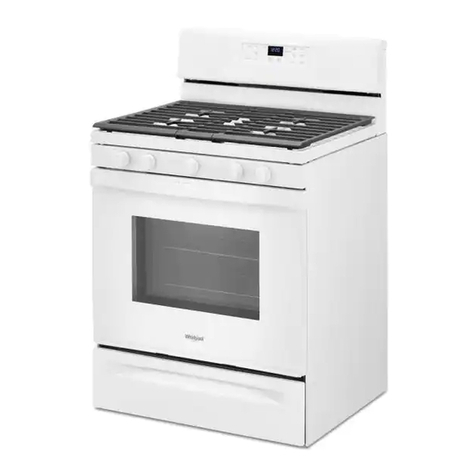
Inglis
Inglis GAS RANGE Use & care guide
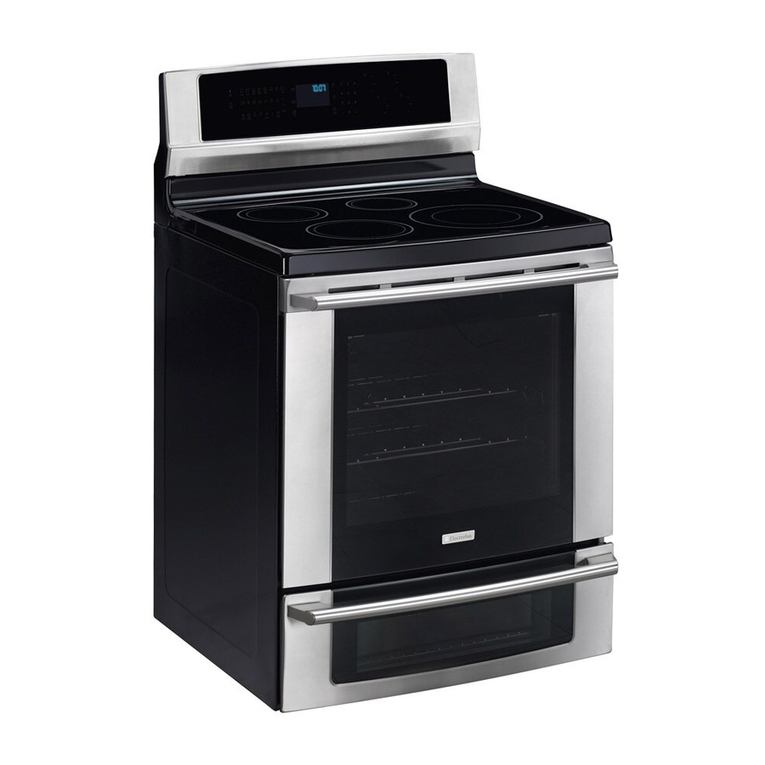
Electrolux
Electrolux EW30IF60IS Use and care guide
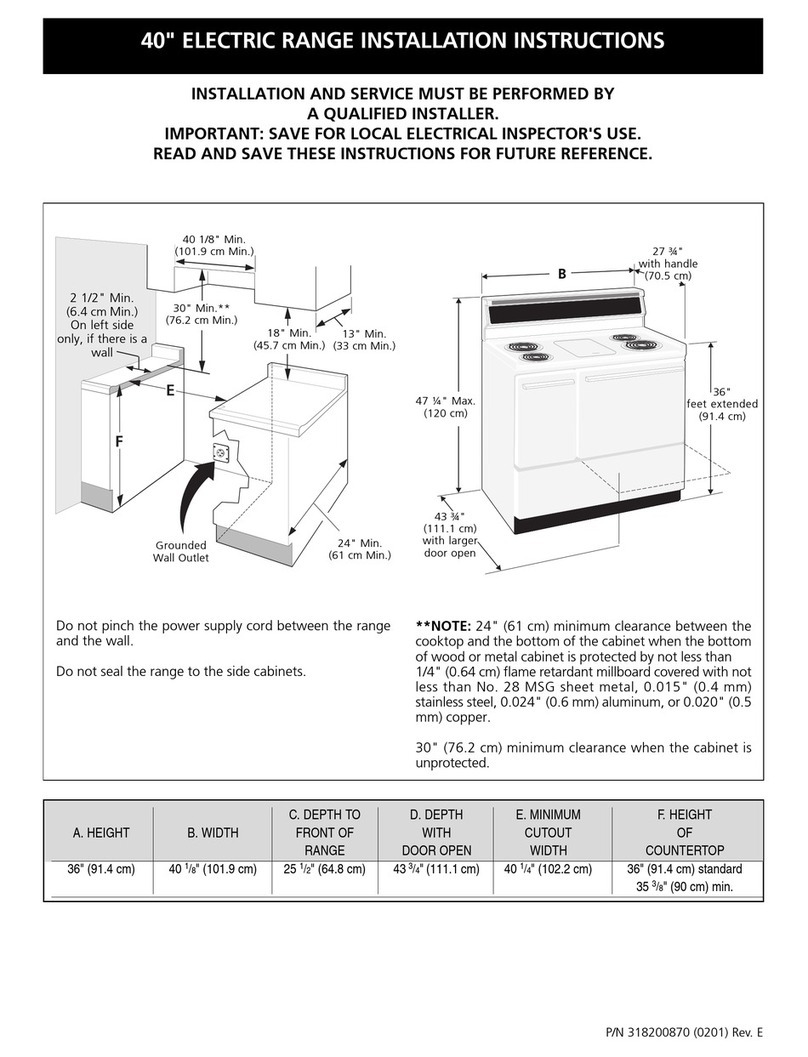
Frigidaire
Frigidaire FEF455WFBE installation instructions

LG
LG LRE30453SB - 30in Electric Range Manual del propietario

GE
GE JGB295DER Dimensions and installation information
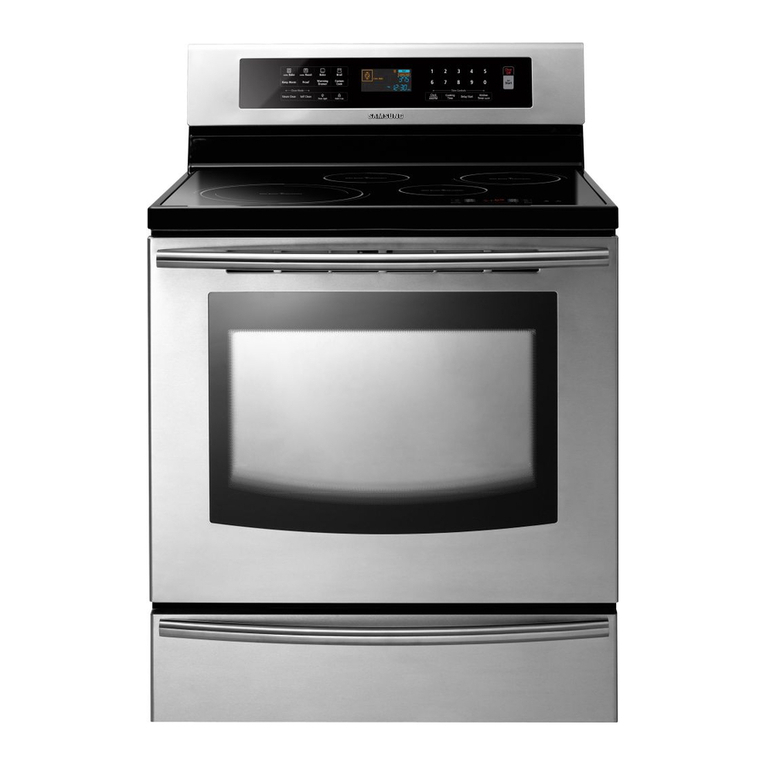
Samsung
Samsung FTQ307 Series user manual

